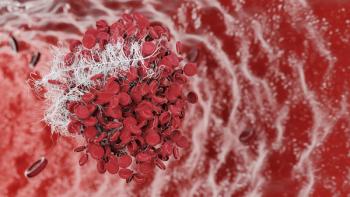
Vitamin D Supplementation Found to Maintain Bone Density in Breast Cancer Patients
A study investigates whether a high-dose of vitamin D with or without exercise is a safe, effective option to prevent bone loss.
Investigators from the University of Rochester James P. Wilmot Cancer Institute have shown that high-dose vitamin D significantly reduces bone loss in patients with breast cancer on aromatase inhibitors with or without exercise. Their findings were presented at the 2019 American Society of Clinical Oncology Annual Meeting being held from May 31 to June 4 in Chicago, IL.
Cancer treatment-induced bone loss is often an adverse effect associated with aromatase inhibitors and can result in osteoporotic fractures. Vitamin D is known to prevent postmenopausal bone loss; however, it was previously unclear if the recommended daily allowance of vitamin D was capable of preventing cancer-treatment-induced bone loss. This phase 2 study aimed to determine whether a high-dose of vitamin D with or without exercise was a safe, effective option to prevent this type of bone loss.
“Cancer treatment-induced bone loss is a significant problem for those with breast cancer patients,” study author Michelle Janelsins, MD, said in a presentation on the findings. “Given the positive effects of weight-bearing exercise in improving BMD in postmenopausal women without cancer and the benefits of exercise for patients with cancer, we were initially looking at this as an intervention for our primary outcome."
Within the study, 115 female participants with a median age of 60 years with non-metastatic breast cancer starting aromatase inhibitors were randomly given either a placebo, a high-dose vitamin D supplementation of 50,000 IU vitamin D3/week, or a high dose vitamin D supplementation of the same amount with an exercise regimen of walking and resistance band training entitled Exercise for Cancer Patients (EXCAP), a standardized, individually-tailored, home-based exercise developed by the University of Rochester, for 24 weeks.
All participants were given the recommended daily allowance, and vitamin D and calcium levels were assessed on weeks 6, 12, 18, and 24. Post treatment included an assessment of vitamin D levels and serum calcium levels. All subjects received 6000 IU vitamin D, and 1000 mg calcium daily.
The results indicated that a high dose of vitamin D significantly improved bone density compared with a placebo. Those that took the placebo lost a significant amount of hip bone median density (BMD) at -1.8%, whereas those with a high-dose vitamin D supplementation maintained it at -0.1% and with exercise at -0.2%. The authors did not see any significant changes of serum calcium levels.
“We ultimately found that vitamin D safely and effectively increases serum 25-OH vitamin D levels, although there were minimum effects of calcium serum levels,” said Dr Janelsins. “We could also see in those who had less optimal amounts of vitamin D, where the dose had even a greater effect in BMD, not just as a prevention but as a treatment.”
This was 1 of the first studies to demonstrate a significant reduction of hip BMD loss in breast cancer due to novel high dose vitamin D intervention with or without exercise. According to the authors, high-dose vitamin D supplementation is safe and feasible for those with this type of breast cancer; however, further testing is needed.
Reference
1. Janelsins MC, Peppone LJ, Reschke JE. A phase II RCT of high-dose vitamin D supplementation and exercise for cancer treatment-induced bone loss in breast cancer patients on aromatase inhibitors. J Clin Oncol 37, 2019 (suppl; abstr 11500). Presented at: 2019 ASCO Annual Meeting. May 31-June 4, 2019. Chicago, Illinois.
Newsletter
Stay informed on drug updates, treatment guidelines, and pharmacy practice trends—subscribe to Pharmacy Times for weekly clinical insights.











































































































































































































